UNSW quantum research in global ‘Top 10 Breakthroughs of 2015’
Physics World, the magazine of the UK’s Institute of Physics, has named an advance in quantum computing by engineers at UNSW among its global “Top Ten Breakthroughs of 2015”.
Physics World, the magazine of the UK’s Institute of Physics, has named an advance in quantum computing by engineers at UNSW among its global “Top Ten Breakthroughs of 2015”.

Physics World, the magazine of the UK’s Institute of Physics, has named an advance by engineers at UNSW Australia among its global “Top Ten Breakthroughs of 2015”.
The research, in which a team of Australian engineers built a quantum logic gate in silicon for the first time, potentially clears the final hurdle to making silicon quantum computers a reality. Led by Andrew Dzurak, a Scientia Professor at the School of Electrical Engineering and Telecommunications at UNSW, it appeared in October this year in the international journal Nature.
The Top Ten is chosen by a panel of editors and reporters of Physics World, one of the world's leading physics magazines. Research must be “fundamentally important, a significant advance in knowledge and show a strong connection between theory and experiment”, the magazine said.
It is a recognition that building a quantum logic gate in silicon is a crucial advance for quantum computing – one of the many our centre at UNSW has made recently.
Dzurak, who is also Director of the NSW node of the Australian National Fabrication Facility, which makes nanofabrication of precision components for quantum research possible, welcomed the recognition for his team which forms part of the UNSW-based Australian Research Council Centre for Quantum Computation and Communication Technology (CQC2T).
“It is a recognition that building a quantum logic gate in silicon is a crucial advance for quantum computing – one of the many our centre at UNSW has made recently,” said Dzurak. “This has been recognised by the Australian government and our industry partners, who this week committed another $46 million in additional funding for our quest to make quantum computers a reality.”

The UNSW Engineering team that built the quantum logic gate – a final hurdle to building a working quantum computer in silicon. Lead author Menno Veldhorst (left) and project leader Andrew Dzurak (right). Photo: Paul Henderson-Kelly
On Tuesday, Telstra announced an in-principle commitment of $10 million plus in-kind support over the next five years to CQC2T – the same day that the Commonwealth Bank of Australia also pledged another $10 million, on top of its $5 million investment in December 2014.
Scientia Professor Michelle Simmons, who heads CQC2T with 180 researchers, said the investments sent a “very powerful message about supporting internationally leading Australian research in areas of breakthrough technology.
“It has been an amazing week for the silicon quantum computing teams at UNSW and the University of Melbourne,” Simmons said. “We are thrilled that leading Australian companies such as the Commonwealth Bank and Telstra are getting behind our world-leading research. It is clear recognition of the fantastic work at our centre over the past decade, and we hope this investment will form the basis of new industries here in Australia.”

UNSW Professors Sven Rogge, Andrea Morello, Michelle Simmons and Andrew Dzurak from the ARC Centre for Quantum Computation and Communication Technology.
Dr Menno Veldhorst, a UNSW Research Fellow and the lead author of the Nature paper, was equally delighted. “We’ve shown that a two-qubit logic gate – the central building block of a quantum computer – can be made in silicon, which we thought was a big deal. It’s nice to see that this has been recognised by our peers, and attracted industry attention.
“Because we use largely the same device technology as existing computer chips, we believe what we have made will be much easier to make into a full-scale processor chip than for any of the leading designs, which mostly rely on exotic elements and technologies. This makes building a quantum computer much more feasible, since it is based on the same manufacturing technology as today’s computer industry,” he added.
Dzurak noted that the team had recently “patented a design for a full-scale quantum computer chip that would allow for millions of our qubits, all doing the types of calculations that we’ve just experimentally demonstrated”.
The advance represents the final physical component needed to realise the promise of super-powerful silicon quantum computers, which harness the science of the very small – the strange behaviour of subatomic particles – to solve computing challenges that are beyond the reach of even today’s fastest supercomputers.
In classical computers, data is rendered as binary bits, which are always in one of two states: 0 or 1. However, a quantum bit (or ‘qubit’) can exist in both of these states at once, a condition known as a superposition. A qubit operation exploits this quantum weirdness by allowing many computations to be performed in parallel (a two-qubit system performs the operation on 4 values, a three-qubit system on 8, and so on).
“If quantum computers are to become a reality, the ability to conduct one- and two-qubit calculations are essential,” said Dzurak, who jointly led the team that in 2012 who demonstrated the first ever silicon qubit, also reported in Nature.
Until now, it had not been possible to make two quantum bits ‘talk’ to each other – and thereby create a logic gate – using silicon. “The silicon chip in your smartphone or tablet already has around one billion transistors on it, with each transistor less than 100 billionths of a metre in size,” said Veldhorst.
“We’ve morphed those silicon transistors into quantum bits by ensuring that each has only one electron associated with it. We then store the binary code of 0 or 1 on the ‘spin’ of the electron, which is associated with the electron’s tiny magnetic field,” he added.
Building a full-scale quantum processor would have major applications in the finance, security and healthcare sectors, allowing the identification and development of new medicines by greatly accelerating the computer-aided design of pharmaceutical compounds (and minimising lengthy trial and error testing); the development of new, lighter and stronger materials spanning consumer electronics to aircraft; and faster searching of massive databases.
Other researchers involved in the ‘top 10’ Nature paper include Professor Kohei M. Itoh of Japan’s Keio University – who provided specialised silicon wafers for the project – along with UNSW’s School of Electrical Engineering and Telecommunications Dr Henry Yang and Professor Andrea Morello, who leads the quantum spin control research team at CQC2T.
In November, Morello’s team proved – with the highest score ever obtained – that a quantum version of computer code can be written, and manipulated, using two quantum bits in a silicon microchip. This removes lingering doubts that such operations can be made reliably enough to allow powerful quantum computers to become a reality.
Only a month earlier, a team led by Simmons and CQC2T’s deputy director, Professor Lloyd Hollenberg of the University of Melbourne designed a 3D silicon chip architecture based on single atom quantum bits, compatible with atomic-scale fabrication techniques – providing a blueprint to build a large-scale quantum computer.
The full Physics World list of Top Ten Breakthroughs of 2015 can be found here.